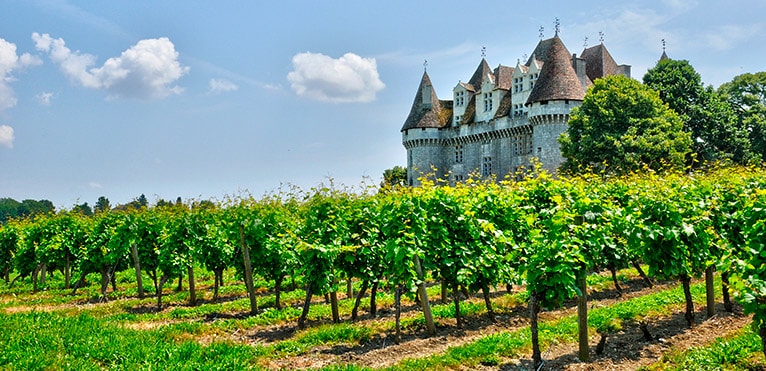
Contents
Monbazillac is an appellation in southwestern France. Composed exclusively of white wines, it is the world’s leading sweet wine-producing appellation. It covers the 5 communes of Monbazillac, Saint-Laurent-des-Vignes, Rouffignac de Sigoulès, Colombier and Pomport. Monbazillac is distinguished by its AOC, obtained in 1936.
Monbazillac is a world-renowned wine
Situated in the heart of the Périgord region, wine production dates back to Gallo-Roman times, but it was in the Middle Ages that Monbazillac was born. The vines had been owned by the Benedictine priory of Saint Martin since 1080. Legend has it that the monks abandoned the vines, leaving them to rot. The fungus botrytis cinerea then develops in the vineyards. Even so, the monks turned this rotten grape into a wine with a new character, full-bodied, with a sweetness never seen before and remarkable power. Since then, the rot caused by the presence of this fungus has been called “noble rot”. Over the centuries, Monbazillac earned its letters of nobility, notably when it was exported to Holland in the 17th century by Huguenots from the South-West, exiled after the revocation of the Edict of Nantes in 1685.
In 1936, Monbazillac was one of the first appellations to be awarded the French AOC label. The main grape varieties used are Semillon (75%), Sauvignon (10%) and Muscadelle (15%). To qualify for the AOC Monbazillac label, vines must have a minimum density of 4,000 vines per hectare, with a maximum yield of between 30 and 40 hectolitres per hectare. Irrigation is prohibited throughout the vineyard. Harvesting is done by hand to select only those bunches that have reached the right stage of ripeness and display the characteristics of noble rot.
The appellation distinguishes between two types of Monbazillac. The first is “classic”, produced from grapes with an average sugar content of 45 grams per liter. The second is called “sélection de grains nobles”, with a much higher sweetness level of 85 grams per liter. Specifically in the latter case, the grapes used must all be affected by botrytis cinerea so that noble rot can express its full potential. The alcohol content must be at least 14% for classic Monbazillac and 17% for Monbazillac “sélection de grains nobles”, otherwise the wine will be downgraded to Côtes de Bergerac moelleux.
The unusual vineyards of Monbazillac
Monbazillac is produced over a 3600-hectare area in the southern Dordogne valley. The distinctive feature of the vineyard is that it faces due north on gently sloping hillsides at an altitude of between 10 and 50 metres.
The climate is temperate thanks to the proximity of the Atlantic Ocean, which provides perfect conditions for the development of the champion botrytis cinerea. In fact, it’s the alternation between warm, sunny periods and cool, damp periods that favors the development of noble rot, an essential element in the formation of high-quality sweet wines. The autumnal mists of Bergerac and the coolness of the north-facing hillsides create this alternation with the sunshine and warmth of Périgord.
The sedimentary soil is composed mainly of clay and limestone, which allows good water retention and efficient filtering thanks to the limestone. Finally, with balanced rainfall, the slope allows good irrigation of the vines.
Monbazillac, a golden wine
Often compared to Sauternes, Monbazillac is generally a blend of 75% Semillon, 10% Sauvignon and 15% Muscadelle. Made from over-ripe grapes, its high sugar content means it should be served at a temperature of between 6° and 8°. Its ageing potential ranges from 6 to 20 years, or even longer for the greatest vintages.
Its color is a remarkable gold. A young Monbazillac is distinguished by its light hue, which intensifies over time until it reaches an amber color after a few decades, especially if it has been aged in barrels. The nose has a strong identity, with honeyed and floral (acacia) aromas that reveal the full power of the wine. A second nose, after oxygenation, reveals dried fruit aromas. Powerful and full-bodied, balanced by suave notes. The identifying note of Monbazillac is the roasted flavor that comes from the evolution of the grapes thanks to botrytis cinerea.
Monbazillac and its accompaniments
Monbazillac’s combination of power and sweet, suave character has made it a world-famous wine among wine lovers. They’ll even pair it perfectly with Périgord produce. It’s easy to pair with foie gras, creamy poultry with mushrooms, Auvergne blue cheese or sweet fruits like melon or Périgord strawberries. It can also be opened for dessert, with creams or cooked fruit.
Monbazillac through the ages
Annual climatic conditions define the exceptionality or otherwise of vintages produced within a geographical area. As with the vast majority of wines from the Southwest, 2005 represents the vintage of the millennium. Vintages of the century were produced in 2001 and 2009. Other outstanding years include 1988, 1990 and 2011 (exceptional vintages) and 1985, 1989, 1996 and 2003 (excellent vintages).
Good addresses in Monbazillac
Domaine du Haut Montlong
Since 1925, the Haut Montlong family estate has been promoting the wines and winegrowing heritage of the Bergerac region. Converted to 100% organic farming, the 45 hectares of vines are devoted to the production of Monbazillac and the Côtes-de-Bergerac appellation. The work of these independent winemakers was rewarded in 2015 with a gold medal for the 2011 vintage of the top-of-the-range 100% Semillon cuvée “Font romaine”.
Château Vari
This Monbazillac estate covers 20 hectares in the Monbazillac and Bergerac appellations. Since 2009, the entire vineyard has been converted to organic viticulture in order to preserve the flora and fauna, enabling the production of exceptional Monbazillac wines. The estate offers 100% muscadelle and 100% sauvignon cuvées, as well as blended wines, including “Château Vari réserve”, which won a silver and bronze medal at the Concours Agricole de Paris on 2 occasions.